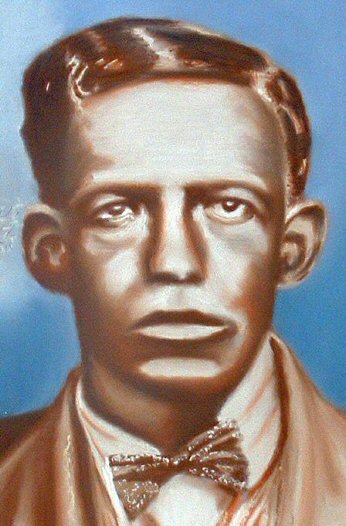
Painting © 2004 Loz
Arkle
Website
© Copyright 2000-2011 Alan White - All
Rights Reserved
Site optimised for Microsoft Internet Explorer
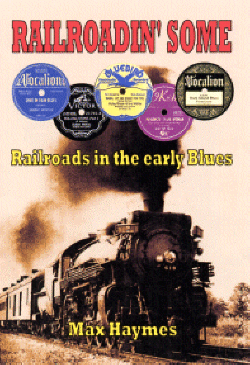
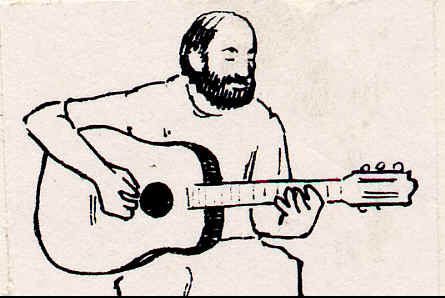

"Spotlight on
Lucille Bogan - Part 5 (Conclusion)"
by Max Haymes
I stated at the outset of this feature on Lucille Bogan, that it was sometimes of dubious value to attribute the truth in a literal sense, to the lyrics sung by blues singers. Having said that, lacking much factual evidence on Bogan, that is precisely what I have done in the last four parts concerning the ‘truth’ about this singer. Conversely, characteristics and the personality of a blues artist can often be gleaned from their blues which if not always literally true for the singer, would be for many of the people listening to the blues.
From
recurring themes and more than casual detail in her recorded lyrics we can
assume fairly safely, that Lucille Bogan was a self-assured, tough and
outward-going character with a warm, vulnerable, inner being. She was involved
in prostitution and bootleg booze and seemed to have an amoral/ atheistic
attitude to life. She married/lived with at least one man who worked on a
Southern railroad. She insisted on being a woman, free, black, and herself; in a
society constrained by the oppression of whites, and the male chauvinism of both
races, in the South. Like Charlie Patton from the Mississippi Delta she was her
own person and did her own ‘thing’ against seemingly, insurmountable odds.
These
details and summary of Lucille Bogan seem entirely in keeping with some fresh
facts related to me by blues collector Paul Swinton from Fleet, Hampshire, UK,
to whom I’m deeply indebted. This information originally came from the U.S.A.
In
1914, Lucille Anderson (born 1st April, 1897) married Nazareth Bogan
a blues singer and railroad man. On 4th
Sept. in either 1915 or 1916 Lucille, while still a teenager, gave birth
to a son, Nazareth Jr. The latter eventually settled in Compton, Ca. with his
wife Mary, where Bob Eagle interviewed him on 28th. Dec. 1974. Bogan told Eagle
he had a sister who died a long time ago. He could only recall one of his
mother’s accompanists: Will Ezell. But Eagle did not ask him anything about
this artist (more’s the pity). Nazareth Jr. explained that Lucille wrote all
her songs at home (in Birmingham, Alabama.) and only travelled to New York and
Chicago to record.
After
a divorce from Nazareth Sr. (who outlived her) Lucille near the end of her life
married James Spencer (born 1919), some 22 years younger than herself. Only 8
weeks after following her son to California, Lucille Bogan died on 10th.
Aug.1948 at her home on 1913, East 114th. Street .Los Angeles, Ca. (1). Dying of
coronary sclerosis, she was buried in “Lincoln Memorial Park Cemetery, Los
Angeles, CA” (2).
Also
from the same indirect U.S. sources we learn that Ms. Bogan was definitely a
prostitute at some stage in her life, and had strong connections with the black
underworld in Birmingham, Alabama. It is possible that she knew Pete Harris, an
excellent slide guitarist from Texas. He had recorded 12 sides for Library of
Congress in 1934. Bogan also might have known a pianist from her hometown by the
name of Wilbert ‘Big Chief’ Ellis (b.1914) who did not get to record until
1945.
This
report confirms that of the one by Sheldon Harris in 1989 concerning her dates
of birth and death, the name of her two (known) husbands and the fact she had
two children.(3). Van Rijn, in the notes to a later L.P. release “Trouble Done
Bore Me Down” (with various artists), said that the writing of the sleeve
notes to the Lucille Bogan L.P. on the same label (Agram) coincided with a then
forthcoming article on Bogan by Bob Eagle “the Australian Alabama expert”,
in “Living Blues” No.44 in 1979. As Eagle only corrected some misconceptions
in the draft copy of his notes, they are sadly now incomplete.
Lucille Bogan was also a music promoter/entrepeneur who “managed Bogan’s Birmingham Busters group”(4) in the late ‘30s in Birmingham. It transpires that this group was fronted by Nazareth Bogan Jr. - then around 20 years old. “In 1937 she brought her son’s group... to the studio. The group recorded without her that same year”. (5). There is no mention in “Blues & Gospel Records 1902-1943” of any session by this group.
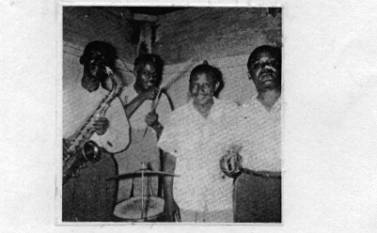 “Bogan‘s
Birmingham Busters” - c.1938. McCoy 2nd. from right.
“Bogan‘s
Birmingham Busters” - c.1938. McCoy 2nd. from right.
However, another member of Bogan’ s Birmingham Busters was pianist Robert McCoy who had first recorded in 1930 accompanying Alabamian harp-blower, Jaybird Coleman. Again, in a support role, McCoy was on a 1937 A.R.C. session with Charlie Campbell and His Red Peppers; featuring guitar bass, and washboard as well as McCoy’s piano. Van Rijn notes “In 1937 a lot of Alabama artists recorded for ARC sessions at the instigation of renowned singer Lucille Bogan”(6). Elsewhere, Robert McCoy is referred to as “Lucille Bogan’s protege”(7). So as well as being a blues singer, Ms. Bogan was a promoter of the music. After World War II, McCoy “…made some trial discs with Lucille for a New York Co. Lucille was mad when the records were rejected”. (8). It is tantalising to think those tests are still in existence - somewhere?
These then are the few facts we have on Lucille Bogan. Unfortunately, in the passing on of even this scant information, to U.S. collectors, possible inaccuracies and a downright error appeared in print’. Renowned blues collector, Richard Spottswood recorded that Bogan had died some 10 years earlier than she actually did (c.1938) in a car accident’. This was some time ago and later on the correct cause of death and the right date came to light. But then in 1993, another well-respected name in U.S. blues circles Lawrence Cohn (who incidentally is the producer of the superb “Roots ‘n’ Blues” Series on Columbia) edited a book entitled (rather unoriginally) “Nothing But The Blues”. By all accounts this is one of THE essential books on the Blues. But Cohn reproduces the erroneous quote from Spottswood: “Bogan died in a car crash in the mid-1930s” (9) with no further detail or information. Quite clearly Cohn took Spottswood at his word, without checking.
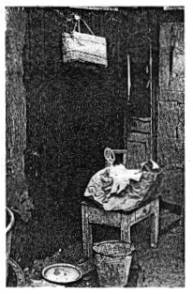
ROOTS
RL-317
1st. L.P. reissue devoted to Bogan (Roland on piano only) Austrian Roots label c.1965.
Often,
reliable conclusions about Lucille Bogan can be drawn from lyrics of her,
fortunately, prodigious recorded output between 1923 and 1935; as I have
discussed at some length already in earlier parts of this article. For instance,
Bogan in 1933 abandons her usual atheistic/amoral Stance when she fell in love,
and in a unique plea (for her) resorts to prayer:
“Gon’
fall down on my knees pray to the Lord above;
Fall on my knees, pray to the Lord above.
Please send me back the only man that I love.” (10)
It
was only 3 days later that she recorded “Mean Twister” where she expresses
her frustrated anger at God for causing the death of “the man I love”. (see
Part 3). This was probably about the same man referred to in “Black Angel
Blues” in 1930 (see Part 3). With the later facts, presented in this issue, it
is obvious Ms. Bogan had had her affair with Will Ezell the barrelhouse pianist,
and been divorced by her first husband Nazareth Bogan Sr., sometime prior to
1929. It is also obvious this man cannot be James Spencer, her second husband,
either. He didn’t come on the scene until the 1940s, not long before Bogan
died. So the ‘real thing’ happened for Lucille Bogan sometime between c.1930
and 1933.
Regarding
her physical features, by her own admission she was “a big fat woman with the
meat shakin’ on my bones” (”Struttin’ My Stuff” (see Part 3), and Van
Rijn & co. state that ‘she may have been remembered by H. C. Speir as the
‘red haired woman’”. (11). Speir was the no.1 blues-talent scout and a
white Mississippian’, who was responsible for getting on record, Charlie
Patton, Son House, Tommy Johnson, Skip James, Robert Johnson, and many more
besides.
Lucille
Bogan was not only a great blues singer but an influential one as well. Her line
“you can miss me now but you can’t when I go home” (“Walkin’ Blues”)
in 1933 crops up in a variation by fiddler Chasey Collins on a different song of
the same title in 1935; that variation makes up the name of Tommy McClennan’s
“You Can Mistreat Me Here” which was his 1st. recorded blues in 1939. Her
“Sloppy Drunk Blues” (1930), a piece that is “possibly related to the
“Vicksburg Blues”(12)., was covered by Leroy Carr, and Walter Davis in the
1930s, Sonny Boy Williamson No.1 in 1941, and Chicagoan Jimmy Rogers in 1954.
Jaybird Coleman recorded her “Coffee Grindin’ Blues” of 1929, nearly a
year later; while her “Black Angel Blues” was made famous, via Tampa Red’s
version in 1934, by B. B. King in post-war years.
Apart
from several unissued titles, Bogan’s complete recordings can be found on C.D.
“Lucille Bogan Vols 1, 2, & 3”on Blues Document BDCD 6036/37/38. Check
out your specialist record shop or try Red Lick Records on mail order.
References
1.
Telephone conversation with Paul Swinton 28/2/94.
2
. “Blues Who’ s Who”. Sheldon
Harris. Da Capo. N.Y. 1989 (Reprint).
3.
Ibid.
4.
Ibid.
5.
Notes to "Women Won’ t Need No Men”. L.P. Lucille Bogan. Agram AB 2005.
Guido Van Rijn & Hans
6.
Notes to Robert McCoy L.P. Oldie Blues OL~2814. Guido Van Rijn. c.1977.
7.
Notes to “Piano Blues Vol.10”. L.P. Various. Magpie PY4410. Bob Hall &
Richard Noblett. 1979.
8.
Notes to Agram AB 2005. Ibid.
9.
Paul Bwinton. Ibid.
10.
“T.&N.O. Blues”. Lucille Bogan as “Bessie Jackson” vo; Walter Roland
pno. 17/7/33. New York City.
11.
Notes to Agram AB 2005. Ibid.
12.
“Deep South Piano”. Karl Gert zur Heide. Studio Vista. 1970.
Copyright © 2001 Max Haymes.
All rights reserved.




